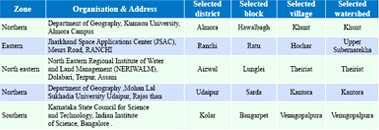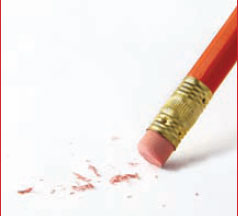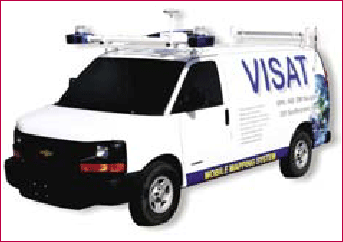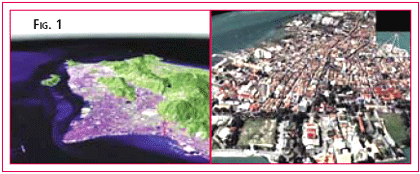Articles in the Mapping Category

Earth-observation techniques attract currently a substantial amount of interest and open fresh research and business opportunities for the geospatial community. They offer nowadays a broad spectrum of diverse platforms, sensors and products. UAV systems are paving their way into novel applications. The development of large format digital aerial camera systems has triggered a renewed interest in aerial photogrammetry…

Nehru Yuva Kendra Sangathan (NYKS) , an autonomous agency under Ministry of Youth Affairs and Sports has the bounden duty to achieve the objectives laid down in the National Youth Policy. The advancement in the field of Science and Technology should be made available to the youth and to the community. As the adaptation of scientific and technological principles and developments, to maximize the use of local resources, are central to empowerment in the quality of life, the Policy recognizes the importance of emerging, modern technologies, particularly in the field of information technology and electronic media, in enabling the youth to perform and achieve in all sectors of their interest.

How would the world look like if you were standing on an arbitrary point on earth? It is not easy to imagine, how a randomly chosen location would look like since most pictures that come into our mind are somewhat special: our home, Piccadilly Square, a picture from National Geographic, or a photo that had been taken on top of a famous summit.

Filipo Rodriguez, Gian Paolo Plaia
Application of cognitive psychology for reduction of mapping errors
Human factors contributing to mapping errors made by operators working on digital mapping systems were studied from Cognitive Psychology perspective to evolve suitable strategies to reduce errors.
Mapping errors
Study area
Large scale topographic maps of better than 1:5000 scale with 1 to 2 m contours are …
Since the staring of GPS, many researchers have investigated its application in aerial photogrammetry. Today, with the full constellation of 24 GPS satellites operational, enabling excellent satellite geometry any time of the day, the need to apply the full potential of GPS for real time aircraft navigation and photogrammetric mapping can be realized. The use of GPS to determine relative positional data for ground control points in a photogrammetric block adjustment is widely accepted and practiced. The camera exposure station coordinates derived by Airborne Kinematic GPS drastically reduces, the number of horizontal and vertical control points needed in aerial triangulation.
In large-scale mapping, the accuracy level of control data required is very high. The lag in time between the camera exposure and the GPS epoch recording in the GPS receiver is critical in deriving accurate coordinates for the exposure station (principal point) coordinates. Due to delay in the electronic transfer of data from camera clicking to GPS receiver in recording the event makes the Lag in time to occur. To meet the high accuracy requirements for the largescale photography and mapping projects the lag in GPS recording time should be derived and applied. In this study, an attempt is made to compute the Lag-time in airborne kinematic GPS derived exposure stations from aerial triangulation.
Aerial triangulation is carried in Digital Photogrammetry work station with conventional method of using ground control points, and the exposure station coordinates are derived. Lag-time is computed by finding difference in coordinates of exposure stations derived from conventional aerial triangulation and from airborne kinematic GPS. The results of this project will help to improve the locational accuracy of GPS derived exposure stations in aerial triangulation.
Methodology
Aerial photography is carried out in the study area on 1:6000 scale with forward overlap at 60% and lateral overlap at 20% using RMK TOP30/23 camera. During aerial photography the airborne GPS is operated to record the exposure coordinates.
The computer controlled navigation system (CCNS) is loaded with flight planning data from World Wide Mission Planning (WWMP). During aerial photography CCNS takes coordinates of aircraft position from navigation system and navigate pilot for alignment as per flight plan. Based on navigation coordinates, CCNS sends signals to camera for exposure. The camera exposure system is connected to Trimble 4000 SSI dual frequency GPS system on board, which records GPS data continuously at 1.0sec sampling rate. During the camera exposure, camera system sends signal to the onboard GPS system, which record each exposure as an event marker in the GPS

SOME of the earliest known maps were made in Iraq which was drawn during 2400 BC for the purpose of land taxation. A Roman map dating 350 AD showed such topographical features as roads, cities, rivers and mountains. Although the basics of land surveying were known but the large scale maps before 16th century were limited to cities and other small areas. Up to the middle of 16th Century, there was little real knowledge of the geography of the most part of the world.

With the continued growth of urban centers all around the world, city planners are required to keep up with up-to-date geographical at a faster rate. This has led to the establishment of spatially-referenced Geographic Information Systems (GIS) for a variety of municipal applications. This information, however, is expensive to obtain by conventional methods. In addition, conventional methods supply only point solutions and are therefore not suited to support the increasingly complex requirements posed by urban centers in a timely fashion. Satellite remote sensing and aerial photogrammetry are two methods which can provide various GIS information at high rates and reasonable cost. However, with the first method, the associated accuracy is not suitable for many applications, and in the second case the near vertical field of view provides only part of the information required.

Over the years topographic mapping generally involved acquisition of data related to the features of the earth, its environs of user’s interest and its graphic depiction on a suitable media, generally paper, ensuring that the accuracy specifications, which depend upon the type of end product, are strictly adhered to.
Over the years topographic mapping generally involved acquisition of data related to the features of the earth, its environs of user’s interest and its graphic depiction on a suitable media, generally paper, ensuring that the accuracy specifications, which depend upon the type of end product, are strictly adhered to.

Spatial data is the fuel for 3D Applications, but all too often the fuel supplied is inappropriate. The software applied and expertise required when modelling a flood event or predicting a cityscape’s lineof-site is exactly the same using highly precise data as it is for generalised data. The difference is in how well that analysis relates to the real world … i.e. whether the analysis is correct or not. Conversely, supplying highly accurate or dense data to a generalised analysis can cost both time and money which is not reflected in the final product. Hence the word of this paper is: appropriate. Apply the most appropriate data to your application. There is nothing wrong with “approximate” or “inexpensive” 3D data, as long as it is appropriate for the level of analysis being performed.








 (5.00 out of 5)
(5.00 out of 5)